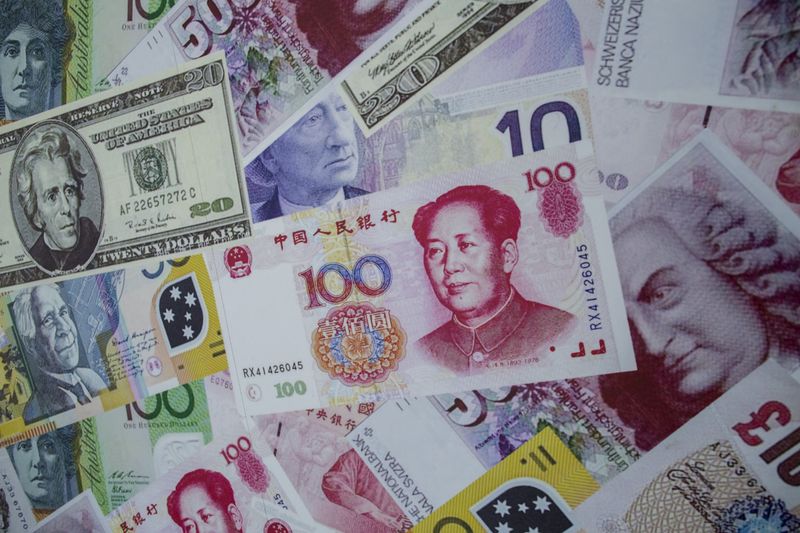Column-Yuan won’t be FX reserve currency if no one buys China’s bonds: McGeever
2023.05.16 01:40

© Reuters. FILE PHOTO: An advertisement poster promoting China’s renminbi (RMB) or yuan , U.S. dollar and Euro exchange services is seen outside at foreign exchange store in Hong Kong, China August 13, 2015. REUTERS/Tyrone Siu
By Jamie McGeever
ORLANDO, Florida (Reuters) – faces significant long-term obstacles to becoming a global reserve currency of any great import, but the biggest challenge in the near term is the fact that nobody wants to buy Chinese bonds.
Foreign investors have been dumping Chinese bonds ever since Russia invaded Ukraine in February last year, wary that Beijing’s ties to Moscow could potentially expose overseas holders of Chinese assets to international sanctions.
The reversal was sudden – non-residents had poured money into Chinese debt securities almost every single month over the preceding decade – and so far, it has been sustained.
Figures through March this year compiled by macroeconomic data research firm Exante Data show that foreigners have been heavy sellers of Chinese bonds every month bar one since Russia invaded Ukraine.
“It is very hard to create a reserve currency, without attractive reserve assets. China has a problem. It wants foreigners to buy bonds but they have been selling since early 2022,” says Jens Nordvig, founder and CEO of Exante Data.
“Both the private sector and the official sector are reducing yuan exposure within their fixed income portfolios,” Nordvig adds.
Exante Data’s figures show foreign investors bought a net $558 billion of Chinese bonds between 2010 and 2021. From February last year through March this year they sold $115 billion.
DE-DOLLARIZATION?
The global ‘de-dollarization’ debate has found a new lease of life recently.
The dollar’s nominal share of global reserves is 58.35%, according to the International Monetary Fund’s currency composition of official foreign exchange reserves, or ‘Cofer’ data, the lowest since the euro’s launch in 1999.
Several countries, including Brazil and other major emerging economies in Asia and the Middle East, have called for trade in oil, commodities and other global goods to be invoiced in non-dollar currencies.
To be sure, the renminbi’s share of world FX reserves has more than doubled in the last seven years to 2.69%, according to the IMF’s Cofer data.
It has grown much faster than the yen, sterling, and currencies like the Australian and Canadian dollars and Swiss franc that are bundled together in the ‘others’ category in the Cofer data. But from a much lower base.
The nominal amount of global reserves held in renminbi was $298 billion at the end of last year, down from a peak of $337 billion 12 months earlier.
But in a pool of $12 trillion global reserves, of which nearly 80% is denominated in dollars and euros, these are very small numbers. There is a long way to go for the yuan to reach even the levels of sterling and the yen at 4.95% and 5.50%, respectively.
RESERVE STATUS
Any currency that has designs on attaining international reserve status must meet several criteria and fulfill several roles.
It should be widely accepted as a unit of reserve for central banks, an accounting unit for international trade, and a transaction currency for trading in global financial assets like equities and bonds.
Beijing has gradually allowed more institutions and central banks to enter the yuan-denominated bond market over the past two decades by relaxing rules around quotas, lock-up periods and registration requirements.
But as IIF economist Jonathan Fortun notes, it is a slow and uneven process, which will be made even slower and more uneven by the heavy selling of Chinese bonds recently.
“Any episode of large outflows concentrated in a single locale, as has been the case of China for much of last year, would be detrimental for a currency to achieve reserve status,” Fortun said.
The IIF’s capital flows data shows some minimal net inflows into China in recent months, but paints a broadly similar picture: demand for Chinese debt has evaporated.
Reluctance to own Chinese bonds comes amid growing pressure form Washington on its Group of Seven allies to impose restrictions on certain investments in China with national security implications. It didn’t make it into the final G7 communique, suggesting other G7 members are less enthusiastic.
But Washington is likely to keep pressing its allies to take a stand against what it considers Beijing’s use of “economic coercion” against other countries.
Beijing, in turn, could view this as the thin end of the wedge, effectively a call for companies, institutions and investors in some of the world’s richest nations to steer clear of China and allocate capital elsewhere.
Which is what bond investors, at least, are already doing.
(The opinions expressed here are those of the author, a columnist for Reuters.)
(By Jamie McGeever)








